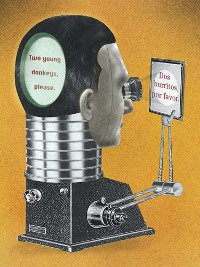| 话题中的页数: [1 2] > | Translation software for Microsoft Word? 论题张贴者: Jorge Amador
|
|---|
I'm starting to explore the possibility of using software to assist me in translating books, and I'm wondering if there is anything out there that fits what I have in mind:
***
I would like to be able to do my work within Microsoft Word and then, when I come across a word or phrase that I'm not sure how to translate, be able to issue a command to call up the translation that I had previously come up with for that term.
***
Explanation:
My work d... See more I'm starting to explore the possibility of using software to assist me in translating books, and I'm wondering if there is anything out there that fits what I have in mind:
***
I would like to be able to do my work within Microsoft Word and then, when I come across a word or phrase that I'm not sure how to translate, be able to issue a command to call up the translation that I had previously come up with for that term.
***
Explanation:
My work deals largely with highly technical material from printed sources (i.e., not available as electronic documents). I often find myself coming across a certain term and wondering -- how the heck did I translate this term before?? As often as not, I find myself having to investigate the term all over again, or to look it up on the pages of a previously translated book and then match it to how I handled it in the translation.
I've considered manually creating a glossary file to keep open in a separate window as I do my work, but I'm wondering if there isn't a program or Word plug-in that will look up the term for me on an on-demand basis.
I have looked at a number of CAT tools, but based on the demos I've seen, they seem to want me to work within THEIR interface. (Moreover, they seem to assume that I have the original in electronic form, which is not always the case.) I am interested specifically in something that would let me do my work normally from within Word. And I don't need the software to try to translate everything, just the specific terms that I ask it to as I go along.
Does such an animal as I describe, actually exist? 
Thanks in advance for any info. ▲ Collapse
| | | | | | Tom in London
英国
Local time: 16:44
正式会员 (自2008)
Italian意大利语译成English英语
Hi Jorge
You can create your own macros within MSWord to memorise particular words or phrases. You configure these yourself, and then run them at the beginning of a translating job. The predetermined phrases or words for which you have written macros will then instantly translate all the instances in the document.
It takes a while to prepare this but it can save a lot of time.
When you're in MSWord, go to the Tools menu and scroll down to Macro.... the rest... See more Hi Jorge
You can create your own macros within MSWord to memorise particular words or phrases. You configure these yourself, and then run them at the beginning of a translating job. The predetermined phrases or words for which you have written macros will then instantly translate all the instances in the document.
It takes a while to prepare this but it can save a lot of time.
When you're in MSWord, go to the Tools menu and scroll down to Macro.... the rest should be self-explanatory, but you can also find online tutorials to help you.
This is actually what a CAT tool does, except that you don't need the CAT tool 
[Edited at 2014-09-29 15:26 GMT] ▲ Collapse
| | | | Clarisa Moraña 
土耳其
Local time: 19:44
正式会员 (自2002)
English英语译成Spanish西班牙语
+ ...
|
|
|
I find that using the WordFinder program in a separate screen is very useful.
1. For translating words using a number of standard dictionaries available from WordFinder.
2. Inserting words into my own glossary in WordFinder, including explanations if necessary and other useful information that I am likely to forget . Eg, words that I have used earlier for a particular subject or client.
A word in the source text can be marked and then searched for in WordFi... See more I find that using the WordFinder program in a separate screen is very useful.
1. For translating words using a number of standard dictionaries available from WordFinder.
2. Inserting words into my own glossary in WordFinder, including explanations if necessary and other useful information that I am likely to forget . Eg, words that I have used earlier for a particular subject or client.
A word in the source text can be marked and then searched for in WordFinder and pasted into the target document. Takes a few seconds. ▲ Collapse
| | | | Tom in London
英国
Local time: 16:44
正式会员 (自2008)
Italian意大利语译成English英语
Jorge specifically requested answers that do NOT involve the use of any CAT tools.
| | | | Erik Freitag 
德国
Local time: 17:44
正式会员 (自2006)
Dutch荷兰语译成German德语
+ ...
Tom in London wrote:
Jorge specifically requested answers that do NOT involve the use of any CAT tools.
Tom, where did Jorge do that? Of course, my command of English is limited, but I can't see that anywhere in Jorge's post.
Anyway, to answer Jorge's question: You seem to be looking for what in the world of computer assisted translation is called concordance. Most CAT tools offer such a function, so just try some of those that work within Word (of which there are quite a few). It means that anything you translate goes into a translation memory (in form of a source and target sentence couple). With the concordance function, you can highlight a given term and the software will look up how you've translated it before.
Tom's suggestion sounds promising, too, as long as the number of terms you need to handle is very limited, and if your target language doesn't use inflection.
| | | |
Did the Asker ask for sighs?
You never know, you know. Someone may find my answer useful.
[Edited at 2014-09-29 16:03 GMT]
| | |
|
|
|
| If it's not a silly question, | Sep 29, 2014 |
isn't this using a sledgehammer to crack a nut? If I'm doing a translation that includes specialist terms and I want to avoid looking them up again later, I just write them down on a piece of paper.
| | | | | Windows' indexing service is your friend | Sep 29, 2014 |
JorgeAmador wrote:
I would like to be able to do my work within Microsoft Word and then, when I come across a word or phrase that I'm not sure how to translate, be able to issue a command to call up the translation that I had previously come up with for that term.
In order to lookup words in your previous translations you can use Windows' indexing service. Organize all your translations & similar resources in an appropriate way in (sub)folders and instruct the indexing service to index only that folders but nothing else.
Later on you can use Windows' standard search (which rests on the indexing service) or a more convenient lookup software. I use Multifultor, a free software that is able to query the indexing service directly, via a single keystroke from within Word and other applications. Additionally it can query several other sources simultaneously, e. g. local & web dictionaries or local glossary files.
Download: see my profile.
| | | | Erik Freitag 
德国
Local time: 17:44
正式会员 (自2006)
Dutch荷兰语译成German德语
+ ...
| Sledgehammer? | Sep 29, 2014 |
philgoddard wrote:
isn't this using a sledgehammer to crack a nut? If I'm doing a translation that includes specialist terms and I want to avoid looking them up again later, I just write them down on a piece of paper.
This may work, if you're sufficiently well organised and you file your entries by narrowly defined subject fields. Also, you need to be able to retrieve your entries, possibly by sorting them alphabetically in a kind of card index box?
IMHO, it's this kind of low-level tasks that a computer is predestinated for. So why not try some simple software? (I do agree though that if concordance is the only thing you want, a major CAT software suite might be overkill).
Also, one big advantage of a concordance tool would be that you can instantly get what translators are always asking for: context instead of isolated words on a word list. This may be less important if you only work in a very narrow subject field, though.
| | | | neilmac
西班牙
Local time: 17:44
Spanish西班牙语译成English英语
+ ...
| I second that | Sep 29, 2014 |
I also recommend WF Classic, which is nice and simple, unlike others I won't name. The glossary function or the TMs do what Jorge is looking for. But then again, I like the WFC interface.
| | |
|
|
|
| Paper source texts are unfriendly | Sep 29, 2014 |
JorgeAmador wrote:
...Moreover, they seem to assume that I have the original in electronic form, which is not always the case...
Unless you digitize (scan) the source doc and apply optical character recognition, you obviously can't get computer-friendly source terms/sentences from paper documents.
So any automated, on-the-fly source-target linking is out of question with paper documents.
Philippe
| | | | Jorge Amador 
Local time: 11:44
English英语译成Spanish西班牙语
+ ...
主题发起人
Wow, it's amazing how many ideas have come in already -- thank you all very much!
Yes, I was hoping to use something that would work from inside Word in some kind of semi-automated fashion.
I used to use the pen-on-paper method. One time when I translated a certain work, though, I ended up writing down so many terms and phrases that halfway through the project I was already spending as much time trying to find where in my notes I had written down the next term I needed,... See more Wow, it's amazing how many ideas have come in already -- thank you all very much!
Yes, I was hoping to use something that would work from inside Word in some kind of semi-automated fashion.
I used to use the pen-on-paper method. One time when I translated a certain work, though, I ended up writing down so many terms and phrases that halfway through the project I was already spending as much time trying to find where in my notes I had written down the next term I needed, as if I'd started the research from scratch. That's when I got the idea that it would be nice to be able to enter the term once, and then the next time it came up I could type the word in the source language, then select it right in Word and have the software either tell me how I'd translated it before, or actually insert my translation.
Soon after that, my business took a turn toward editing (in the same language), and the issue faded in importance. It's only recently that I'm once again facing new challenges justifying the sort of function we're talking about.
You've given me a lot of products and Windows/Word features to look into. Looks like I've got my work cut out for me...
[Edited at 2014-09-29 16:57 GMT] ▲ Collapse
| | | | | He's asked about anything, including CAT tools, that works inside Word, | Sep 29, 2014 |
Tom in London wrote:
Jorge specifically requested answers that do NOT involve the use of any CAT tools.
and WordFast Classic certainly does!
| | | | | 话题中的页数: [1 2] > | To report site rules violations or get help, contact a site moderator: You can also contact site staff by submitting a support request » Translation software for Microsoft Word? | CafeTran Espresso | You've never met a CAT tool this clever!
Translate faster & easier, using a sophisticated CAT tool built by a translator / developer.
Accept jobs from clients who use Trados, MemoQ, Wordfast & major CAT tools.
Download and start using CafeTran Espresso -- for free
Buy now! » |
| | Pastey | Your smart companion app
Pastey is an innovative desktop application that bridges the gap between human expertise and artificial intelligence. With intuitive keyboard shortcuts, Pastey transforms your source text into AI-powered draft translations.
Find out more » |
|
| | | | X Sign in to your ProZ.com account... | | | | | |












